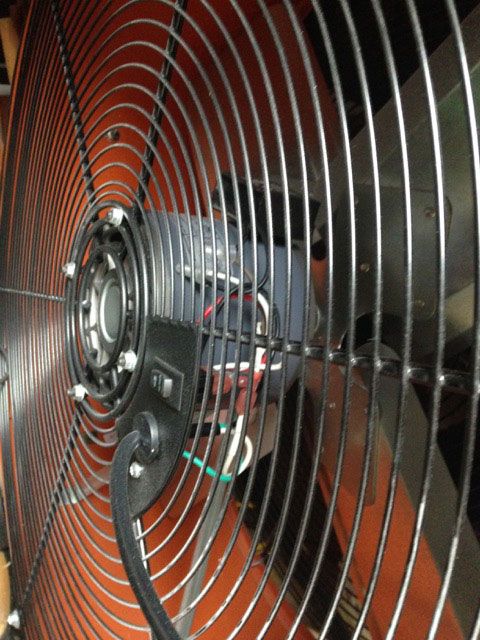We may receive a commission when you use our affiliate links. However, this does not impact our recommendations.
Earlier this year I decided to set up a spray booth in my shop so I could spray finishes on crappy days. It did not turn out well.
Usually I spray outside, so I have to wait for a pleasant day with the right humidity, no pollen, low bug count, no rain and etc. Sometimes the weather does not cooperate, so a makeshift spray booth seemed just the thing. So I bought tarps, filters and an industrial fan to ventilate things.
It seemed to be working really well. I wear a respirator when spraying, and when I’d remove my respirator when using the spray booth I was surprised how little solvent smell was in the air.
I was well-pleased.
My finishes, however, were not.
The fan moved so much air that my film finishes would become rough to the touch because of all the turbulence. It was similar to what happens when you spray too close to the work or spray over a wet spot two or three times by accident.
At first I thought I had the settings wrong on my gun. I did not. Then I thought I had the wrong needle size. Nope. Perhaps my turbine was losing power and couldn’t atomize the finish? Nein. My finish was old? Someone had put a handful of sand in the finish?
It was the air flow. Too much. Way too much.
I put the fan in the shed for now and have returned to spraying outside on suitable days. Maybe I’ll try again with a smaller fan, different filters or a different configuration. Or not.
— Christopher Schwarz
Here are some supplies and tools we find essential in our everyday work around the shop. We may receive a commission from sales referred by our links; however, we have carefully selected these products for their usefulness and quality.










Try a voltage reostat in the fan circuit to slow down the fan speed..
I know there has to be a joke about fans in there somewhere. “Is that your biggest fan?”
Anywho, I have struggled with the fair-weather spray system for years and have considered a spray booth in the shop, but it has seemed daunting. Opting for the wipe on finish has been the go-to for me, but that might change and probably should. Thanks for the info on the ventilation Chris, much appreciated, and sorry for the cheese.
Brian Noel
Easy enough to control the CFM or your chosen fan, just add a baffle or louvers or in any way constrict the opening and yur dun! But I’m with one of the earlier posts, your mix is off. I live in central FL where I have to contend with 100% humidity which leads to blushing if I lay it on too heavy. Even then, all I have to do is mist the finish with solvent and the blushing disappears.
Like all things mastered in Woodville, we have to try try again. Think: micro-bevels and freehand sharpening.
The goal should be to engineer an air velocity of 100 feet per minute in the area where you’re actually spraying. Note that that’s a different measurement than the total cubic feet per minute that the fan is moving.
I doubt turbulence is the real culprit. Although not many relevant details are provided, I suspect the real problem is improper solvents in the coating material for the application conditions. A “retarder” such as used for use in high temperatures might help. The increased airflow, assuming all other conditions such as temperature and humidity are the same, could be causing solvents to evaporate at higher rates, especially the more volatile ones. I would contact the coating manufacturer to discuss.
Should be careful Chris using a standard fan and motor when spraying what could be volatile substances. I don’t know what the standard in the USA is but in Australia hazardous area motors have to be used usually rated EeXD or EeXE explosion proof and non sparking and a case strong enough to contain an explosion if the motor goes BOOM through over heating or a spark. Same goes for heating a cold workshop, wood dust can be combustible and an intrinsically safe heater should be used, Ie… something without exposed red hot elements Oil Coulomb heaters are good as there is no exposed elements .
This type of safety might be a good discussion point.
I have found that with my latest project a small table that adhering to the man code and neglecting to read the application instructions on deep red pigment water based stain Black cherry General Finish followed by spraying Minwax water based poly finish . The result was a pink top coat. Fail . You can mix empire and mission style and get the stink eye but top coat and wax you get the fish eye.
In our very nicely appointed industrial chemistry lab, our fume hoods move about 700 CFM – that classifies as Class A (which is very good). And the air in our lab changes about six times per hour and there is never a chemical smell (but lots of chemicals present). Perhaps you could engineer your a flow to be in that vicinity (500-ish?).
My advice is go for a laminar flow situation and pull the fresh air into the “tent” through a couple of different ports. And if you’re wearing a respirator for personal protection anyway, you shouldn’t have to over-engineer the spray tent.
Joe
It would appear that you need a Little Ass fan. They are quite popular, as I’m sure you have heard the advertising slogan, “Everybody likes a …………………………………..”